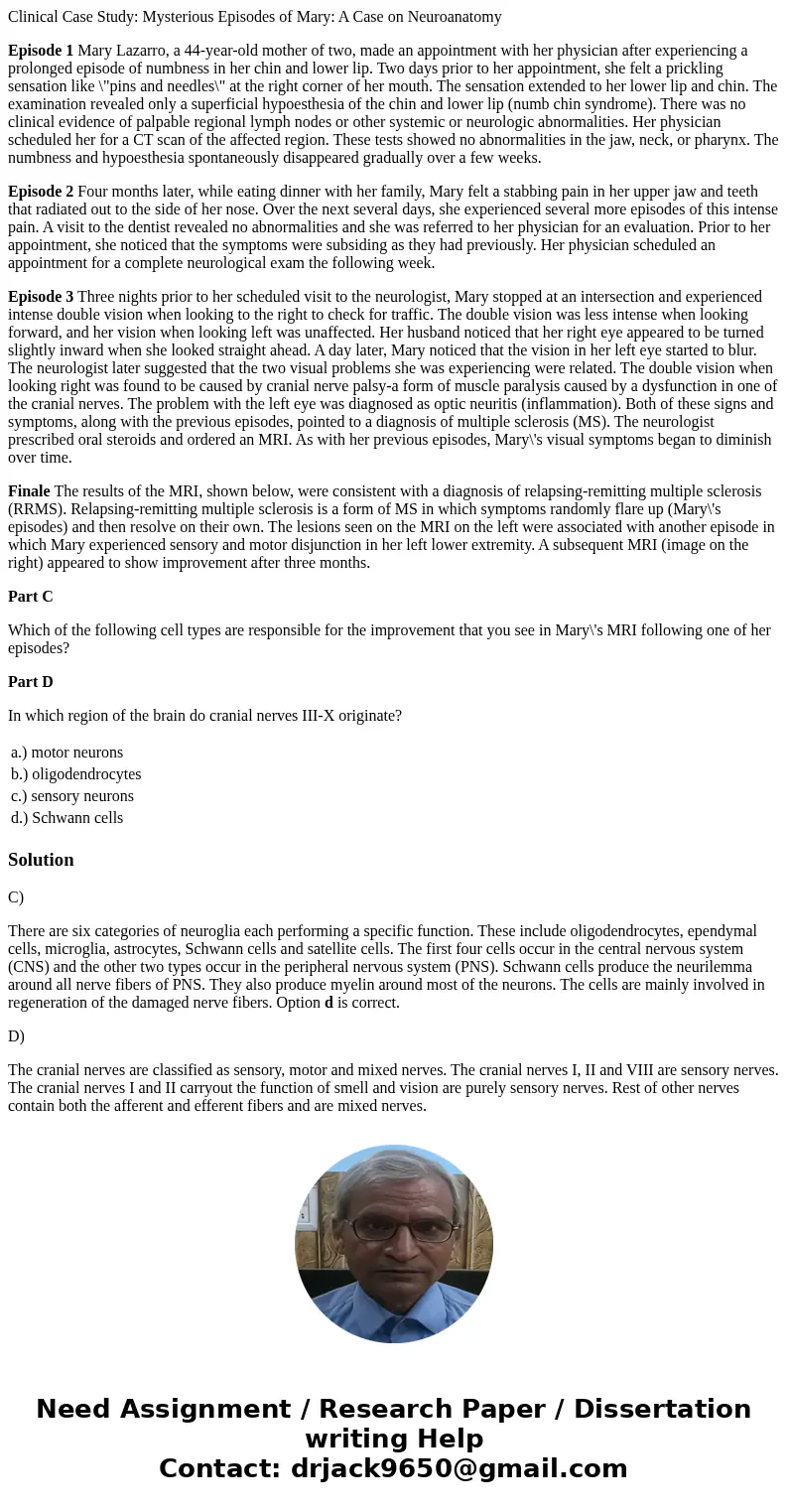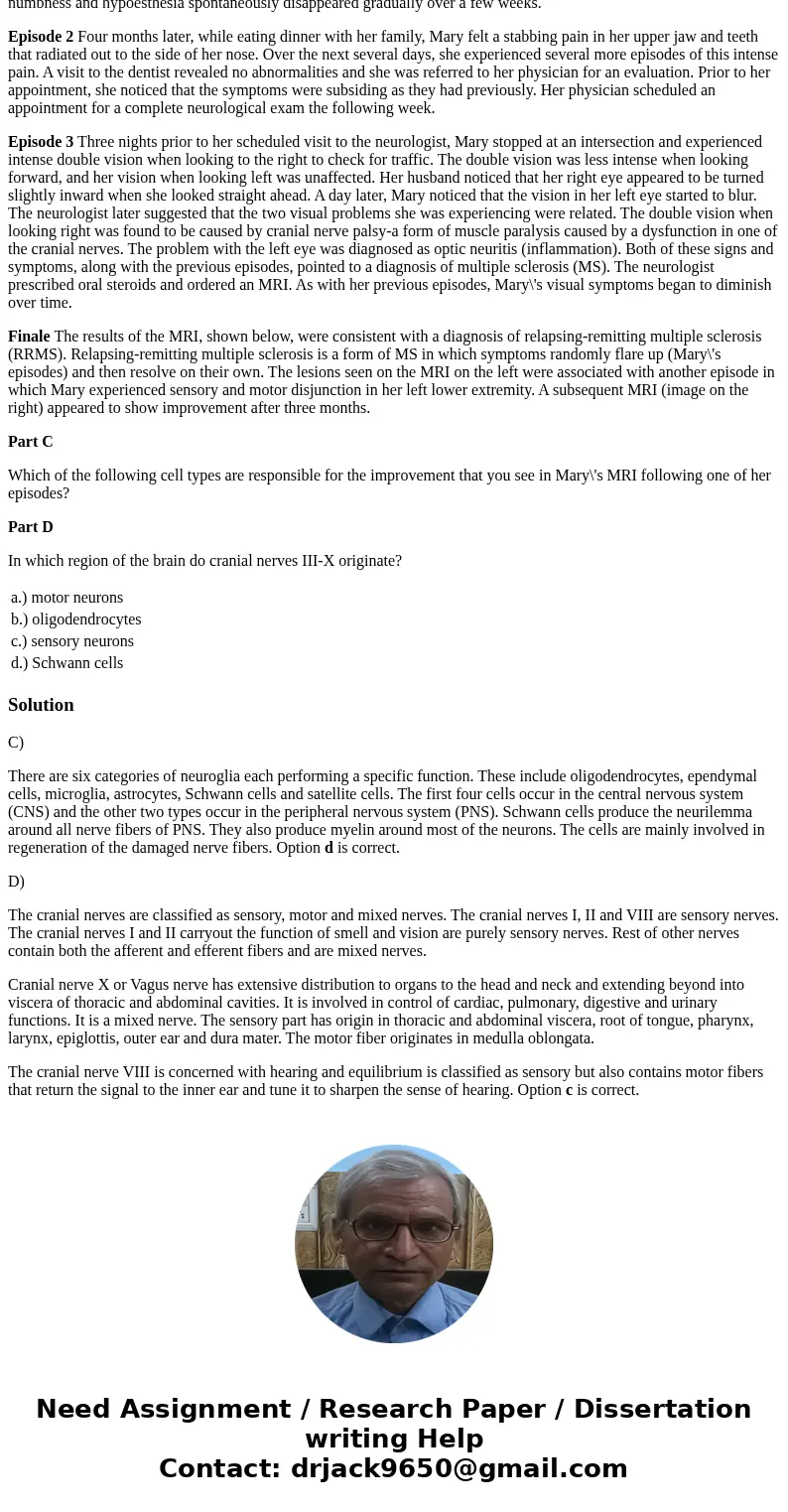Clinical Case Study Mysterious Episodes of Mary A Case on Ne
Clinical Case Study: Mysterious Episodes of Mary: A Case on Neuroanatomy
Episode 1 Mary Lazarro, a 44-year-old mother of two, made an appointment with her physician after experiencing a prolonged episode of numbness in her chin and lower lip. Two days prior to her appointment, she felt a prickling sensation like \"pins and needles\" at the right corner of her mouth. The sensation extended to her lower lip and chin. The examination revealed only a superficial hypoesthesia of the chin and lower lip (numb chin syndrome). There was no clinical evidence of palpable regional lymph nodes or other systemic or neurologic abnormalities. Her physician scheduled her for a CT scan of the affected region. These tests showed no abnormalities in the jaw, neck, or pharynx. The numbness and hypoesthesia spontaneously disappeared gradually over a few weeks.
Episode 2 Four months later, while eating dinner with her family, Mary felt a stabbing pain in her upper jaw and teeth that radiated out to the side of her nose. Over the next several days, she experienced several more episodes of this intense pain. A visit to the dentist revealed no abnormalities and she was referred to her physician for an evaluation. Prior to her appointment, she noticed that the symptoms were subsiding as they had previously. Her physician scheduled an appointment for a complete neurological exam the following week.
Episode 3 Three nights prior to her scheduled visit to the neurologist, Mary stopped at an intersection and experienced intense double vision when looking to the right to check for traffic. The double vision was less intense when looking forward, and her vision when looking left was unaffected. Her husband noticed that her right eye appeared to be turned slightly inward when she looked straight ahead. A day later, Mary noticed that the vision in her left eye started to blur. The neurologist later suggested that the two visual problems she was experiencing were related. The double vision when looking right was found to be caused by cranial nerve palsy-a form of muscle paralysis caused by a dysfunction in one of the cranial nerves. The problem with the left eye was diagnosed as optic neuritis (inflammation). Both of these signs and symptoms, along with the previous episodes, pointed to a diagnosis of multiple sclerosis (MS). The neurologist prescribed oral steroids and ordered an MRI. As with her previous episodes, Mary\'s visual symptoms began to diminish over time.
Finale The results of the MRI, shown below, were consistent with a diagnosis of relapsing-remitting multiple sclerosis (RRMS). Relapsing-remitting multiple sclerosis is a form of MS in which symptoms randomly flare up (Mary\'s episodes) and then resolve on their own. The lesions seen on the MRI on the left were associated with another episode in which Mary experienced sensory and motor disjunction in her left lower extremity. A subsequent MRI (image on the right) appeared to show improvement after three months.
Part C
Which of the following cell types are responsible for the improvement that you see in Mary\'s MRI following one of her episodes?
Part D
In which region of the brain do cranial nerves III-X originate?
| a.) motor neurons |
| b.) oligodendrocytes |
| c.) sensory neurons |
| d.) Schwann cells |
Solution
C)
There are six categories of neuroglia each performing a specific function. These include oligodendrocytes, ependymal cells, microglia, astrocytes, Schwann cells and satellite cells. The first four cells occur in the central nervous system (CNS) and the other two types occur in the peripheral nervous system (PNS). Schwann cells produce the neurilemma around all nerve fibers of PNS. They also produce myelin around most of the neurons. The cells are mainly involved in regeneration of the damaged nerve fibers. Option d is correct.
D)
The cranial nerves are classified as sensory, motor and mixed nerves. The cranial nerves I, II and VIII are sensory nerves. The cranial nerves I and II carryout the function of smell and vision are purely sensory nerves. Rest of other nerves contain both the afferent and efferent fibers and are mixed nerves.
Cranial nerve X or Vagus nerve has extensive distribution to organs to the head and neck and extending beyond into viscera of thoracic and abdominal cavities. It is involved in control of cardiac, pulmonary, digestive and urinary functions. It is a mixed nerve. The sensory part has origin in thoracic and abdominal viscera, root of tongue, pharynx, larynx, epiglottis, outer ear and dura mater. The motor fiber originates in medulla oblongata.
The cranial nerve VIII is concerned with hearing and equilibrium is classified as sensory but also contains motor fibers that return the signal to the inner ear and tune it to sharpen the sense of hearing. Option c is correct.


 Homework Sourse
Homework Sourse